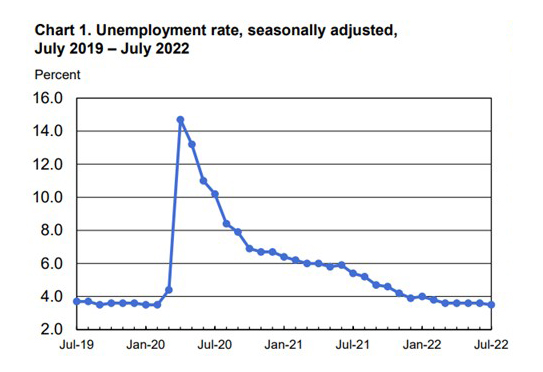
Solid Jobs Report Move Employment, Unemployment Rate to Pre-Pandemic Levels

Total nonfarm employment jumped by 528,000 jobs in July, more than double consensus expectations and pushing the unemployment rate to 3.5 percent, the Bureau of Labor Statistics reported Friday.
Economists had expected job gains of 250,000 in July. But BLS reported widespread job growth, led by gains in leisure and hospitality, professional and business services, and health care. Both total nonfarm employment and the unemployment rate have returned to their February 2020 pre-pandemic levels.

The unemployment rate edged down to 3.5 percent, while the number of unemployed persons edged down to 5.7 million. These measures have returned to their levels in February 2020, prior to the coronavirus pandemic.
BLS revised total nonfarm payroll employment for May up by 2,000, from +384,000 to +386,000, and for June was p by 26,000, from +372,000 to +398,000. With these revisions, employment in May and June combined is 28,000 higher than previously reported.
The labor force participation rate, at 62.1 percent, and the employment-population ratio, at 60.0 percent, were little changed over the month. Both measures remain below their February 2020 values (63.4 percent and 61.2 percent, respectively).
“Job growth in July remained strong, and with upward revisions to May and June, job growth has averaged 437,000 per month over the last three months,” said Mike Fratantoni, Chief Economist with the Mortgage Bankers Association. “Despite the negative reading on second quarter GDP, this is not a picture of an economy in recession. And even though initial claims for unemployment insurance have increased modestly in recent weeks, these data show that the pace of hiring, spurred by more than 10 million job openings, continues to exceed any increase in layoffs.”
Fratantoni noted construction employment increased by 32,000 over the month. “Although housing demand waned due to a spike in mortgage rates, builders continue to add supply to a market that needs it,” he said. “With solid wage gains and a recent drop in rates, some buyers may return to the market. This remains one of the strongest job markets in the past 50 years, no comfort for those hoping for a slowdown which would reduce inflation and lead to a less aggressive path of rate hikes from the Federal Reserve.”
“All of the 22 million jobs lost in the pandemic have been regained; residential building jobs are up from pre-pandemic levels, while nonresidential remain below,” said Odeta Kushi, Deputy Chief Economist with First American Financial Corp., Santa Ana, Calif. “Residential building construction employment increased by 2,900 in July while nonresidential picked up by 4,900. Residential building employment is up 7.5% compared to pre-pandemic, while nonresidential building employment remains 4.7% below.”
Kushi said while the housing sector slows, the construction industry has faced a skilled labor shortage for many years and will continue to try and fill empty positions. The best way to attract and retain workers is to pay more,” she said.
“If the U.S. economy is in a recession, no one seems to have told employers,” said Jay Bryson, Chief Economist with Well Fargo Economics, Charlotte, N.C. “This marked the second fastest pace of job growth in 2022. Employment growth was broad-based with nearly all major sectors adding jobs in the month.”
Bryson noted, however, economic data are sending mixed messages at present, and the white-hot payroll numbers look increasingly out-of-line with other data points. “That said, employment growth of more than half a million jobs per month and a falling unemployment rate are hard to ignore, and we suspect this data will give the [Federal Open Market Committee] the confidence it needs to push ahead aggressively with its fight against inflation. At least a 50 basis-point rate hike at the September 20-21 FOMC meeting seems likely at this point in time, and yet another 75 bps hike could be in store if inflation over the next two CPI reports shows no signs of trending lower.”
“[Friday’s] jobs report from the Bureau of Labor Statistics points to continuing strength in the labor market,” said Doug Duncan, Chief Economist with Fannie Mae, Washington, D.C. “We also note that residential construction employment (including specialty trade contractors) grew by 14,100 in July; while this number has been volatile lately, this month’s solid gains should help homebuilders to fulfill their current orders.”
BLS said average hourly earnings for all employees on private nonfarm payrolls rose by 15 cents, or 0.5 percent, to $32.27. Over the past 12 months, average hourly earnings have increased by 5.2 percent. In July, average hourly earnings of private-sector production and nonsupervisory employees rose by 11 cents, or 0.4 percent, to $27.57.
The average workweek for all employees on private nonfarm payrolls was 34.6 hours for the fifth month in a row. In manufacturing, the average workweek for all employees held at 40.4 hours, and overtime increased by 0.1 hour to 3.3 hours. The average workweek for production and nonsupervisory employees on private nonfarm payrolls remained unchanged at 34.0 hours.
Fratantoni noted strong demand for workers continues to push wages up, with average hourly earnings up 5.2 percent compared to last year. “The unemployment rate fell to 3.5%, matching the pre-pandemic low,” he said. “With business demand for workers still strong, wage pressures should persist.”
